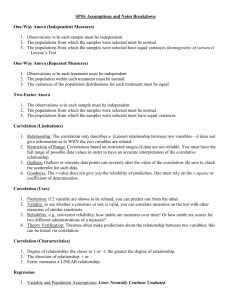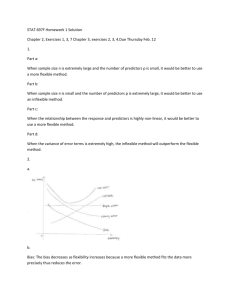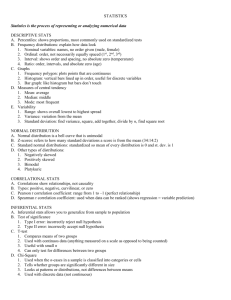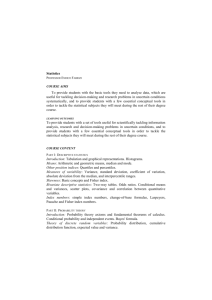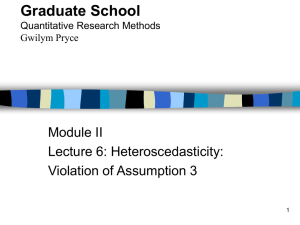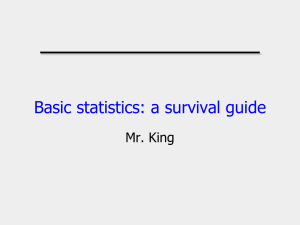04/01 - David Youngberg
advertisement
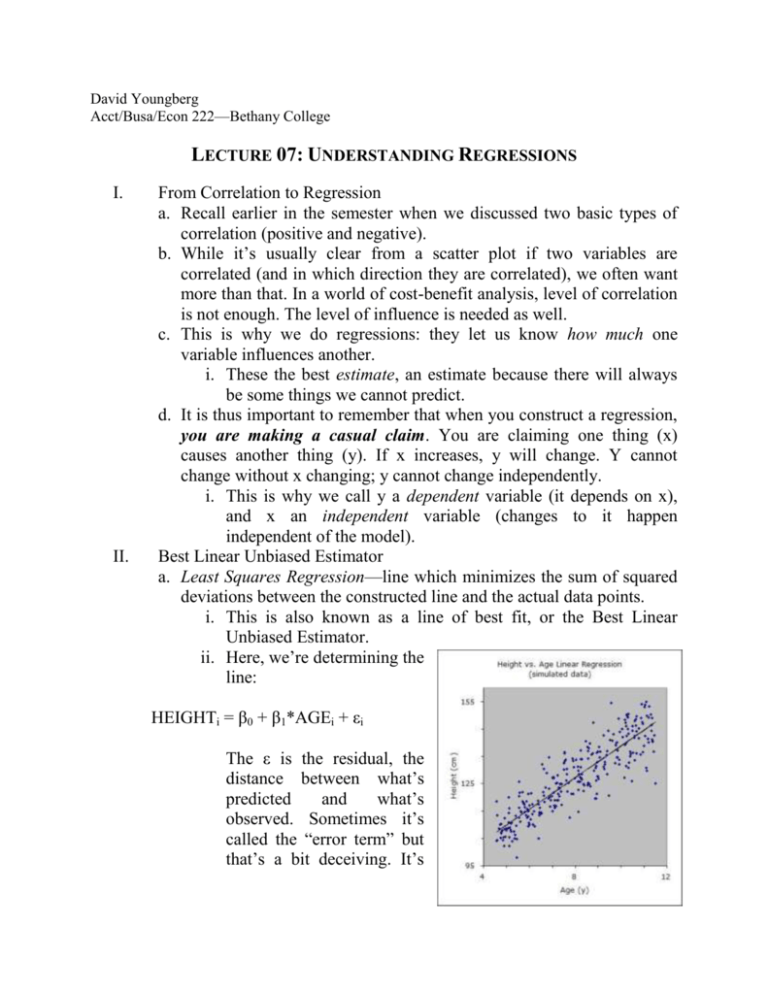
David Youngberg Acct/Busa/Econ 222—Bethany College LECTURE 07: UNDERSTANDING REGRESSIONS I. II. From Correlation to Regression a. Recall earlier in the semester when we discussed two basic types of correlation (positive and negative). b. While it’s usually clear from a scatter plot if two variables are correlated (and in which direction they are correlated), we often want more than that. In a world of cost-benefit analysis, level of correlation is not enough. The level of influence is needed as well. c. This is why we do regressions: they let us know how much one variable influences another. i. These the best estimate, an estimate because there will always be some things we cannot predict. d. It is thus important to remember that when you construct a regression, you are making a casual claim. You are claiming one thing (x) causes another thing (y). If x increases, y will change. Y cannot change without x changing; y cannot change independently. i. This is why we call y a dependent variable (it depends on x), and x an independent variable (changes to it happen independent of the model). Best Linear Unbiased Estimator a. Least Squares Regression—line which minimizes the sum of squared deviations between the constructed line and the actual data points. i. This is also known as a line of best fit, or the Best Linear Unbiased Estimator. ii. Here, we’re determining the line: HEIGHTi = β0 + β1*AGEi + εi The ε is the residual, the distance between what’s predicted and what’s observed. Sometimes it’s called the “error term” but that’s a bit deceiving. It’s III. IV. not suggesting anyone did anything wrong. iii. This line is determined by minimizing the sum of the squared distance between the line and a data point. iv. Note it’s not a perfect fit. That’s because other factors influence height besides age. What others factors could play a role? b. β1 is the slope of the line. It tells us how much age matters to height. Suppose the line is HEIGHTi = 80 + 5.6 AGEi + εi. i. We can estimate that someone who is 8 years old is probably 80 + 5.6(8) = 124.8 cm tall. For every year someone ages, they get 5.6 cm taller. ii. If the average height of our sample is 130 cm, we can also say that for every year someone ages, they get (5.6/130 = 0.043) 4.3% taller.1 iii. These summary sentences are what I referred to earlier as your “punchline.” c. For each variable in the regression (and it’s possible to have many, which we will discuss later), Excel will tell you the following: i. Coefficient—this is the beta-value for the variable; the slope. ii. t-statistic—ratio of the estimated coefficient to the standard error of the estimated coefficient (coefficient divided by error). iii. Confidence interval—describes the range that the true value of the parameter could fall with a certain level of certainty (usually 95%). It outputs this result twice; I have no idea why. iv. p-value—tells you the threshold of significance you achieve for a particular t-statistic. (Remember critical t values changes based on degrees of freedom.) If the p-value is below 0.05, it’s significant to the 5% (95% confidence) level. If below 0.01, it’s significant to the 1% level, etc. iClicker Homoscedasticity a. Linear regressions have several assumptions which we will be exploring. A notable one is homoscedasticity—the variance (or the deviation) from the regression line is the same, regardless the value of the independent variable(s). b. When we lack homoscedasticity we have heteroscedasticity, or the variance is not the same for all values of our independent variable. This latter method is helpful when your dependent variable isn’t something intuitive, such as a measure of the freedom of the press. Similarly, if your independent variable isn’t something obvious, you’ll want to use percents as well. “For every 1% freer countries become [1% being 1% of the average level of freedom for your sample], GDP per person increases by $500.” 1 i. Heteroscedasticity can show up in different ways. Here we see how variance increases as income increases. But if variance decreased, or increased and then decreased, or decreased and then increased, etc. we’d still have a problem. V. c. Why should we care? Heteroscedasticity biases our error which means our t-statistic is higher (or lower) than it should be. i. In practice, it is not much higher so if you’re significant to the 1% level, you’re probably fine. ii. But if your values are barely significant (close to 5%), then you have a problem. If you’d adjust for heteroscedasticity, your significant result might cease being so! d. A potential correction to heteroscedasticity is a poor model. If you’re not using a logarithmic function, try transforming your data so you do. i. If this doesn’t work, don’t worry about it. There are better corrections but it is beyond the scope of this class (and Excel can’t handle it). e. The simplest way to detect heteroscedasticity is to make a scatter plot and add a regression line. This visualization test is intuitive, but not precise. f. In lab we will do what’s called the Breusch-Pagan Test for a better approximation. Analysis of Variance a. This material will be covered in the lab after the exam. We cover it now because it is also a good set up for the lecture two weeks from today. b. We’ve previously used the t-test to compare the means of two samples. But sometimes we want to compare the variance (is one sample more consistent than another). Other times we want to compare multiple samples at the same time. i. Why don’t we just run the t-test several times, once for each pair of samples? Because (A) that gets really time consuming and (B) the Central Limit Theorem. Remember CLT states that sample means will approximate a normal distribution. Any two samples might be different based on chance (say, two on opposite sides of the distribution). You’ll commit Type I Error. ii. Example: You’re curious if a particular type of occupation likes a new product more than others. You might compare just teachers and factory workers. Then you add writers, and then police officers, and then musicians, etc. The more points of comparison you have, the more likely a difference will be statistically significant by chance. Type I Error. iii. Example: You’re curious if a new soap is better than a current brand. So you ask the treatment and control a battery to assess based on several metrics: smell; color; shape; feeling of cleanliness right after use; cleanliness an hour after use; six hours after use; quickness to lather; etc. The more metrics you add, the more likely you are to conclude its different based solely on chance. Type I Error. c. We can correct this problem with Analysis of Variance (ANOVA)—a method for testing if the means of several groups are equal; a generalized t-test. d. ANOVA is determined by the F-ratio, or 𝐹= 𝑣𝑎𝑟𝑖𝑎𝑛𝑐𝑒 𝑏𝑒𝑡𝑤𝑒𝑒𝑛 𝑡ℎ𝑒 𝑑𝑖𝑓𝑓𝑒𝑟𝑒𝑛𝑡 𝑔𝑟𝑜𝑢𝑝𝑠 𝑣𝑎𝑟𝑖𝑎𝑛𝑐𝑒 𝑤𝑖𝑡ℎ𝑖𝑛 𝑡ℎ𝑒 𝑑𝑖𝑓𝑓𝑒𝑟𝑒𝑛𝑡 𝑔𝑟𝑜𝑢𝑝𝑠 i. Since Excel will be calculating the F-ratio for us, and it’s a long calculation, I won’t go into it here. e. ANOVA relies of the F-distribution, which is really a family of distributions depending on the degrees of freedom in the numerator and the degrees of freedom in the denominator. i. The distribution is positively skewed and ranges from zero to infinity. f. There are several ways to use ANOVA: i. Two-sample for variance—check to see if two samples have the same variance. ii. Single factor—check if samples are different across groups. For example, “Do these different routes from A to B take different amounts of time?” iii. Two factor—check if samples are different across groups and within groups. This calculation is different from the single factor even for the differences across groups (which both return). For example, “Do these different routes from A to B take different amounts of time and—since several different drivers drove each route—does the average time between drivers differ?” iv. In other words, two factor ANOVA checks if the average is different between one type of group (here, the driver)… Driver Adams Brockman Callahan Davies Edgeworth Travel Time from Starbrick to Warren U.S. 6 West End Hickory Rte. 59 18 17 21 22 16 23 23 22 21 21 26 22 23 22 29 25 25 24 28 28 v. …and then uses that information to check if the average is different between another type of group (here, the route). Driver Adams Brockman Callahan Davies Edgeworth VI. Travel Time from Starbrick to Warren U.S. 6 West End Hickory Rte. 59 18 17 21 22 16 23 23 22 21 21 26 22 23 22 29 25 25 24 28 28 vi. It’s crucial to understand that the two-way ANOVA assessment will get a different result than the one-way ANOVA, even for the same treatment. If we did one-way ANOVA for routes, we’d find the routes take the same time. A two-way ANOVA would find that the route does matter. vii. Which one to use depends on if your secondary treatment factor (here, the driver) is important to consider. Which one to use is often a judgment call. iClicker LAB SECTION (PRE EXAM) VII. Chapter 13 a. You must delete any observations which lacks data for variable. If you do not, you’ll get an error saying “Regression - LNST() function returns error. Please check input ranges again.” i. The easiest way to eliminate such observations is to use the sort function. Sorting the data by each variable will put all the observations with a missing value for that variable in the same place. VIII. Breusch-Pagan Test a. Step 1—run a regression in Excel, making sure to select the “Residuals” option. (Not “Standardized Residuals.”) Let’s assume it appears in C1:C15. b. Step 2—create a new column, call it Res2, and square all the residuals (=C1^2, =C2^2 in the next row, etc). c. Step 3—divide the sum of the residuals (you can see that in the output for the regression) by your total number of observations. d. Step 4—create a new variable, let’s call it “bp” which is the squared residual divided by the value you got in Step 3 (=Res2/(RSS/n)) e. Step 5—note in the residual output is a “Predicted Y” column. You will now run a regression with “Predicted Y” as the independent and “bp” as the dependent. f. Step 6—divide the ESS (regression sum of squares) by two and use the result in a chi test. Type =CHIDIST(x,1), where x is half of ESS. (Your degrees of freedom will always be one.) If you get more than 0.05, you have homoscedasticity. IX. Homework a. Chapter 13: 1-2 b. Using the data for the class, regress so GDP/capita predicts the Deaths/1000. Then use the Breusch-Pagan Test to test for heteroscedasticity. Interpret the results. (I just need the final regression results and the result from the Chi distribution.) LAB SECTION (POST EXAM) X. XI. Chapter 12 Homework a. Chapter 12: 1, 3-6



